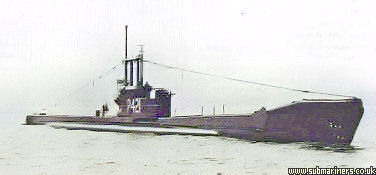Affray Riddle
Sports divers using new deep water techniques have reached the wreck of the Affray, the Royal Navy submarine in which 75 sailors lost their lives almost 50 years ago in a disaster that remains shrouded in mystery.
The divers were the first to see the wreck, which lies at about 270ft in one of the deepest parts of the Channel, since members of Royal Navy underwater recovery units in the early fifties.
Aware that the site remains the last resting-place of the crew, the team of 11 divers, led by Christina Campbell and Innes McCartney, took nothing from the site other than video footage. The video has been requested by Royal Navy experts anxious to solve the mystery behind the cause of the worst British submarine accident since the Second World War.
I was one of the first pair to go down the guide rope lowered onto the side," Mr. McCartney said. "It really was the most impressive sight to go down to that depth where there is no ambient light only to turn on a lamp and see the unmistakable shape of the submarine.She is a most magnificent sight, towering almost 30ft clear of the seabed and looking as formidable as she did in her heyday. She remains a significant and salutary reminder of our naval heritage
By not tampering with the wreck or removing any artefacts the divers did not contravene the Protection of Military Remains Act which was drawn up after the Falklands War to protect sites including naval wrecks.
Numerous Royal Navy submarines and U-boats lost in shallower parts of the Channel are often visited by divers but it was only with special gas mixtures including helium that the Affray could be reached. Martin Rowden, an experienced wreck diver from Australia, said the danger increases exponentially at depths greater than 100ft with a considerable risk at the depth of the Affray.
Mr McCartney said the submarine was intact on the sea bed and the right way up with only a slight lean to port. The wooden letters of her nameplate have long since decomposed but the shape of her 281ft hull was unmistakable.
The loss of the Affray caused a sensation when it was reported missing on April 17, 1951, a day after sailing from Portsmouth. As well as its normal crew of 61, it carried two classes of submarine officers under training and a small party of Royal Marines. After failing to transmit a routine report, the Royal Navy began its procedure for dealing with lost submarines and for several anxious days hopes remained that Affray could be found and the submariners recovered.
There were stories of tapping noises and Morse messages being picked up by the searching vessels but, as the days went by and more and more ships took part in the search, hopes began to fade.
As the weeks passed rumours circulated of the Amphion Class submarine being stolen by the Russians and the press reported almost daily as the search of thousands of square miles of seabed continued.
After two months the submarine was eventually found 37 miles from its last reported diving position. The loss of life represented one of the worst in the history of Royal Navy submarines and the Admiralty was anxious to establish the cause. Remote-controlled television cameras were used for the first time and they found damage to the snort mast, used when submerged, to draw in air for the diesel engines to run.
The mast appeared to have snapped, allowing water to flood into the submarine but mystery remained as to the cause of the break. Experts recovered part of the mast and carried out tests metallurgical faults but theories about possible collisions or onboard explosions remained. Mr. McCartney's divers could shed little light on the issue, although they could confirm there was no other damage to the hull and all hatches and torpedo tubes remained sealed.
Perhaps the only way to establish exactly what happened would be to raise the Affray but with no other A-class boats in service there is no military logic to carrying out a salvage as nothing could be learnt to protect other vessels.
Mr. McCartney plans to lead another expedition to find the M1, one of the earliest Royal Navy submarines, which mounted a vast 14-inch gun on its hull.
Comments
0 comments
This form is for you to comment on, or add additional information to this page. Any questions will be deleted. If you wish to ask a question or otherwise contact the Branch or the Webmaster. Please use the Contact Us page or ask your question on our Facebook Page
Note: All submissions are subject to webmaster approval prior to appearing on the page. As a SPAM prevention measure, any comments containing links to other sites will be automatically discarded



